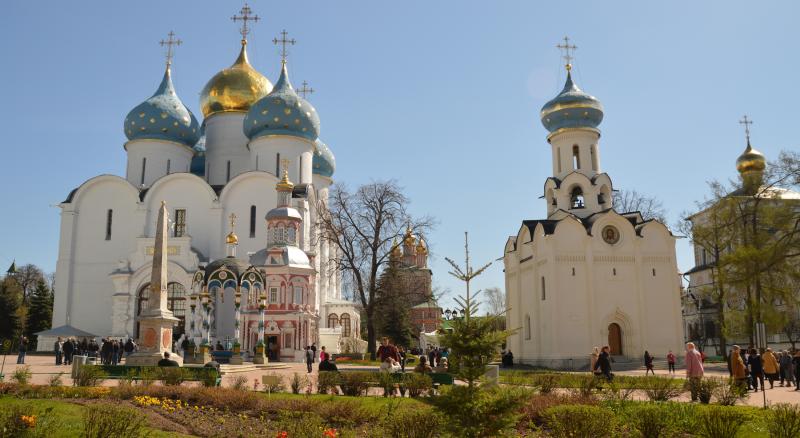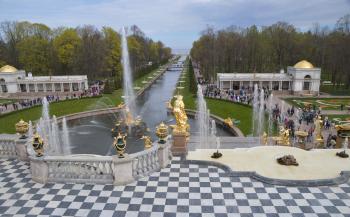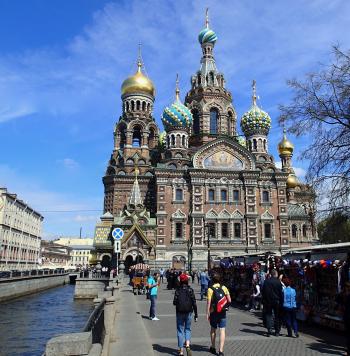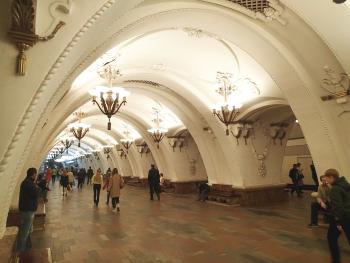A DIY adventure (with a little local help) in Russia
This article appears on page 6 of the January 2018 issue.
Russia has been on our travel wish list for quite some time, though it is a destination that can be intimidating for DIY travelers. A lot of research and good planning were necessary, but we were rewarded with an amazing trip. We did divert a bit from our normal DIY routine at times by hiring a driver or a guide for particular areas.
Moscow introduction
Following our journey through Georgia (Dec. ’17, p. 40), we flew Georgian Airways from Tbilisi to Moscow’s Vnukovo International Airport. To our surprise, we arrived and cleared Passport Control and Customs in less than 15 minutes.
At all major airports in Russia, you will be given a migration card when you clear Passport Control. Keep it, as you will need it to be registered at your hotel, a requirement if you are staying seven days or more. You will also need the card to depart Russia.
Traveling with only carry-on luggage, as we always try to do, helps to speed the process, but outside of the US, carry-on baggage allowances are much more restrictive, so always check your airline’s policy.
Our prearranged driver dropped us off at the downtown Kadashevskaya Hotel. This hotel, booked on Booking.com, had a view across the Moskva River to the Kremlin. Walking time was only 10 minutes to Red Square and St. Basil’s Cathedral.
Our room cost $122 per night, with a great breakfast buffet included. The hotel’s Italian restaurant was good but pricey.
As we walked to Red Square, a light, unseasonal snowfall followed us to St. Basil’s. We took a few photos and looked into the historic GUM department store (built 1889-1893) along the way.
At 9:30 p.m. we met our guide, Alex, who took us on a nighttime photography tour of Moscow’s dazzling city center. St. Basil’s, the Kremlin and the Moskva River were magnificent sights at night, despite the cold evening. This tour was one of our favorite experiences.
Having returned to our hotel after midnight, we slept in the next morning and later took a self-guided tour of the Kremlin, Cathedral Square, Red Square and St. Basil’s. We did not go inside St. Basil’s due to the queue (and having read that the inside wasn’t nearly as spectacular as the outside).
At the Kremlin, we witnessed the Changing of the Guard at the Tomb of the Unknown Soldier and were extremely fortunate to see the weekly Saturday parade with horses, soldiers and a band playing that takes place in Cathedral Square.
We peered inside the area churches that were open and found them to be very ornate, with almost gaudy gilding throughout — a stark contrast to the simplistic, much older churches we had seen in Georgia.
A leisurely walk through the Alexander Garden, with the flowers and trees in spring bloom, was picturesque. It was a relaxing, slow-down day.
A day with a local
We spent the next day with Olga, a young Russian woman who had befriended us on the Russia TripAdvisor forum. She graciously volunteered to spend the day with us at less touristy places, gratis. We thoroughly enjoyed our time with her and getting to know her.
While riding on the Metro (a day pass cost 180 rubles, or about $3), we were able to see and photograph six different Metro stations. Some of the stations were 275 feet underground. Fortunately, there were escalators. Unfortunately, the signage in Cyrillic was not conducive to our DIY travel.
The stations all were unique, each equally stunning. Murals and mosaics depicted the history of Russia.
Millions of locals rush through these stations every day, hardly taking a glance at the chandeliers, sculptures, stained-glass windows, mosaics and pink, white and black marble.
We visited Kolomenskoye Park — very popular with locals — to relax and enjoy the flowering fruit trees, and then we strolled Old Arbat, a street with craft shops and cafés.
After taking photos in three more Metro stations, we visited the beautiful Apothecary Garden and had an excellent dinner nearby at a somewhat funky restaurant, Chaikhona #1, a favorite of Muscovites. It served an array of cuisines from former Soviet Republic countries. Its eclectic, colorful interior was fun.
We were able to have a delightful conversation with Olga before she escorted us back to our hotel. How many Americans do you think would spend a day with a foreigner, gratis? This was a special interaction for us and an awesome experience.
The Golden Ring
Early the next day, Vladimir, our driver to the ancient cities of the Golden Ring, met us at our hotel. He spoke only basic English, so the iTranslate app on our iPhone came in handy at times. It could operate offline, which proved to be a huge advantage.
We had customized an itinerary for our visit to the Golden Ring cities and had sent the draft to Nanotrip (welcome@nanotrip.ru), who quoted us 38,000 rubles ($650) for a driver only. The price did not include our lodging, food or entrance fees, but reviews of the company were excellent and their prices were competitive.
Our first stop was the Trinity Lavra of St. Sergius in Sergiev-Posad. This Russian Orthodox monastery was founded in 1345 and was expanded several times throughout its history.
The Cathedral of the Assumption, topped by beautiful blue, onion-shaped domes with gold stars, was built in 1585, and the older main cathedral (Trinity Cathedral), in the 1420s.
This active monastery, with 300 monks on site, is the spiritual center of the Russian Orthodox Church.
After lunch, we transferred to Rostov Veliky, home to the Rostov Kremlin, with its 6-foot-thick white walls and its 11 circular wooden towers, that sits alongside Lake Nero. The main church inside the walls has frescoes dating from 1675.
At the end of our touring day, we drove to Kuptsov Dom, a 3-star hotel we had booked on Booking.com for $67 per night. Our room was clean and spacious, and the price included breakfast.
Monastery visits
The next morning we visited the Spaso-Preobrazhensky Monastery in Yaroslavl, which dates back to the 13th or 14th century (though most of what’s seen today was built in the 16th century — still quite old by American standards). In the center of this large cathedral were many amazing frescoes, and atop some of the domes were large, gold, Sputnik-shaped ornaments. There are three cathedrals in this historic complex.
The roads along the Golden Ring are in disrepair, so distances are measured in time rather than kilometers. After a 2-hour drive, we had a late lunch in a quaint restaurant in Suzdal called Chainaya (Kremlyovskaya St., 106). The traditional food was very good and inexpensive.
It was raining, so we decided to call it a day and relax at our 3-star boutique hotel, the Suzdal Inn. Our very nice room was booked on Booking.
com for $62 a night, including breakfast.
The next morning we made a brief stop at the Museum of Wooden Architecture, featuring a reconstruction of a classical village, with houses filled with everyday utensils, clothing, bedding and tools.
Also in Suzdal, we visited the Savior Monastery of St. Euthymius, the Assumption Church, the bell tower and the 7-domed Cathedral of the Transfiguration of the Savior. Recent restoration uncovered some bright frescoes dating to 1680 that were gorgeous!
Inside, we enjoyed four monks singing a cappella and appreciated the excellent acoustics.
The awesome interior of the 12th-century Assumption Cathedral in Vladimir featured impressive murals and frescoes. The complex was beautiful even in the rain.
Visiting the ancient Russian cities felt like seeing the real Russia. The rural setting and historical homes were a distinct contrast from what we found in the cities.
Arriving back in Moscow, we treated our driver to a nice dinner before he dropped us at Leningradsky train station at 10 p.m.
On to St. Petersburg
We splurged when we booked the Grand Express overnight train to St. Petersburg, which departed at 11:40 p.m. and arrived in St. Petersburg at 8:36 the next morning. We booked (ahead of time) a luxury compartment for two with its own bathroom and shower for $330, including breakfast and a driver to our hotel. Tickets booked online early provide a savings of about $50.
We arrived refreshed and on time in St. Petersburg. We called the owner of the apartment we’d rented, Dmitry, who graciously met us and allowed us to check in right away. We reserved this fabulous find (#7226451) on HolidayLettings (holidaylettings.com).
We paid only $80 per night (net after a refunded deposit) for this modern, clean, 1,500-square-foot apartment, and, best of all, it was only a 10-minute walk to Nevsky Prospekt and The Hermitage, with restaurants nearby. It was very secure inside a coded, locked courtyard.
On our first evening in St. Petersburg, we attended the ballet at the old Mariinsky Theatre, opened in 1860. Being surrounded by the ornate beauty of the theater, it was difficult to concentrate on the performance.
Over the next three days, we walked to the city-center sites, with some shopping interspersed. St. Petersburg is a beautiful European-style city, as opposed to the more traditional Russian glamour of Moscow. Its canals and rivers cross through the city, adding to its charm.
We used Uber a few times after grocery shopping or to travel long distances, and it was amazingly cheap. Between points within the city center, it cost less than $2 per ride. Since it’s charged directly to your credit card and you are texted a receipt, there’s no need to worry about getting ripped off. Having non-English-speaking drivers was never an issue.
The Russian Orthodox churches in St. Petersburg were more opulent and gilded than those in Moscow and much more so than the Georgian Orthodox ones, but the churches are not nearly as old. Our favorite church in the city was the Church of the Savior on the Spilled Blood, which contains over 7,500 square meters of exquisite mosaics and plenty of gold leaf.
Nearby is Kazan Cathedral, which was enormous in scale. Its exterior and interior columns made it seem like a palatial hall rather than a church, and the huge bronze doors are copies of the doors of the Baptistery in Florence.
After seeing a few more impressive cathedrals, we spent a few hours visiting The Hermitage. founded in 1764 by Catherine the Great. The building, itself, pastel green and trimmed in white, was striking. We looked at a few antiquities but spent most of our time in the Winter Palace. It is lavish, opulent… just about any superlative you could choose. History enthusiasts could spend days there exploring its exhibits.
Day-tripping
We had hired a driver, Alex, for a day trip to Peterhof Gardens and The Catherine Palace in Pushkin. He charged $80 for the 5- to 6-hour itinerary.
Peterhof Gardens is a photographer’s fantasy. We were captivated by the Grand Cascade and really enjoyed walking in the majestic manicured gardens. You could easily spend a day there, but we had only a few hours.
We then drove to Pushkin, the location of Catherine the Great’s palace. Begun in 1717, it was later totally redone by Empress Elizabeth to its present form. More than 100 kilograms (220 pounds) of gold were used on the stucco facade and the statues along the roof.
Its interior’s best features are the series of rooms of the Golden Enfilade, which includes the huge ballroom, or the Hall of Lights (with a spectacular painted ceiling), and other smaller rooms, among them the famous Amber Room (reconstructed in 2003).
This palace contained more gold than any place we have ever visited.
The entrance fees were quite high there (700 rubles), and the flow of visitors was not smoothly coordinated (as it was at The Hermitage). We weaved around all the tour groups, which required a lot of patience, and it was quite warm inside.
The gardens were nothing special, especially after visiting Peterhof.
We loved St. Petersburg and Moscow — they are uniquely different — but our primary disappointment with St. Petersburg was the number and size of the tour groups we encountered there, many from cruise ships.
We never felt unsafe, threatened or uncomfortable while in Russia, which thwarted our preconceived concerns.
ATM-machine availability in Russia was good, and our credit card was widely accepted. However, use of both was more limited in the smaller towns along the Golden Ring. Russia was not expensive by European standards; the ruble’s low value versus the US dollar made it more affordable.
English is not widely spoken in Russia, so we used the iTranslate app frequently and highly recommend the offline version ($36 per year).
We found the Russian people we met to be helpful and friendly, just like people we’ve met throughout most of the world.
Preparing for a visit
Getting a Russian visa is a cumbersome process and expensive but not overly complicated for Americans.
A voucher (letter of invitation) is required to apply for a Russian visa. Most people try to get their vouchers from their hotels in Russia, but hotels are not always cooperative.
There is a much easier way. You can obtain your voucher from ivisa.ru rather than trying to get one from each hotel where you plan to stay. You fill out their online form and pay $25 per person. We received our vouchers by email in pdf form within 10 minutes.
We used Travel Document Systems’ (traveldocs.com) Houston office for handling the processing of our visa applications with the Russian consulate. I think the fee for tourist visas went up in 2017, but when we applied, in the fall of 2016, the fee was a bit under $200 per person and TDS’s processing fee was about $100.
It was, by far, the most expensive visa we’ve had to get for any place we have visited, but it was still worth the effort and cost to be able to experience this interesting country.
This was a wonderful, diversified DIY adventure that most anyone could do. Some activities required good mobility and a lot of walking, some of which was strenuous.
Black-and-white images cannot do justice to the magnificent, colorful exteriors of the churches or, especially, the ornate, gilded interiors.
We were able to snag open-jaw frequent-flyer tickets, so the total cost for our 23-day itinerary — including our travels in Georgia — was a very reasonable $6,500 for two.
If you’re looking for advice (but not itinerary design) for your own trip, we can be reached by email at lc4vino@gmail.com.




